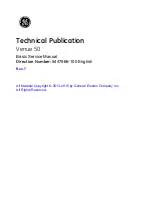
RTC
®
5 PC Interface Board
Rev. 1.9 e
8 Advanced Functions for Scan Head and Laser Control
153
innovators for industry
8.1.2 Configuring Status Return
Behavior
Selecting Data Signals
The digital servo architecture of i
DRIVE
®
scan systems
allows a wide variety of data signals to be returned
to the control board. Each axis is assigned its own
status channel which transmits data to the controller
board every 10
µ
s: The STATUS channel is provided
for the X axis (galvanometer scanner 2) and the
STATUS1 channel for the Y axis (galvanometer
scanner 1). This opens up possibilities such as moni-
toring the galvanometer scanners’ actual values
during execution of an application or carrying out
comprehensive troubleshooting in case of opera-
tional malfunction.
command allows selection of
which data the scan head should return to the control
board. The available data signals are described in
detail in the manual of the respective scan system and
in the
reference. The selected data sources will be trans-
mitted until another source is selected.
In addition to the above-mentioned “normal” status
information, i
DRIVE
®
scan systems with SL2-100
interfaces (operated without an XY2-100 converter)
can also simultaneously return additional slowly-
changing status information (e.g. current tempera-
tures of the galvanometer scanners). The command
allows specification of data that the
scan system should return. With
data transmission to the scan system takes place via
a user data bit across multiple transmission cycles
parallel to normal communication. In contrast to
, neither the transmission of
position data nor the movements of the galva-
nometer scanners are interrupted (also see
). Likewise, the scan system’s return of addi-
tional status information takes place via a user data
bit. Here, neither the above-mentioned “normal”
status returns nor the associated functions (e.g.
/
control) are adversely affected.
After every power-up or reset (starting with approx.
five seconds after the power-up or reset), the scan
system transmits (on all receive channels) the
XY2-100 status word (and no information i.e. 0 via
the user data bit).
Querying Data
Data received by the RTC
®
5 (with the exception of
user data bits) can be read asynchronously at any
time via the commands
or
or synchronously via the command
(see
and the corresponding
command references). Note that switching of the
data source is followed by a short (serial trans-
mission-related) delay before the first data is trans-
mitted. Therefore, after switching data sources
waiting times of approx. 50
µ
s can occur before
reading the data.
The value ranges of transmitted data and the possible
status states are described in the command reference
of the
command.
Notes
command queries the
XY2-100 status word, which the scan system
always returns in parallel with other status infor-
mation, as per the SL2-100 protocol. In contrast,
if the scan system is controlled via an XY2-100
converter, the XY2-100 status word is only
returned when this data type is specifically
selected (otherwise,
would
return unusable data).
The scan system’s status information returned via the
user data bit (across multiple transmission cycles) can
be queried by the RTC
®
5 (in intervals of approx. 2 ms)
with
. The value ranges of returned
signals and the possible status states are described in
the command reference of the
command and the user manual of the respective scan
system. Due to the bitwise serial nature of data trans-
mission and a possible synchronization time, a
waiting period of at least 4-6 ms should be inserted
between
to
ensure reliable receipt of the requested type of new
data.
















































